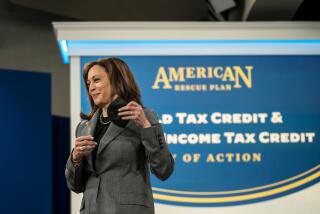Current Tax Code Still Best Option, Rubin Says
- Share via
WASHINGTON — After a careful study of tax reform proposals, measures already introduced in Congress as well as plans dreamed up by executive branch officials, the Clinton Administration has concluded that nothing suggested so far would be better than the much-criticized existing system, Treasury Secretary Robert E. Rubin said Wednesday.
Talking to a group of reporters over breakfast, Rubin said President Clinton is prepared to defend the status quo in an election year debate over tax reform unless someone suggests something better than any of the plans now on the table.
“If everything that is proposed and everything we can come up with is not clearly better. . . , then doing nothing is the right thing to do,” Rubin said.
He said that it is politically tempting for Clinton to offer a tax reform plan in advance of next year’s election because the current system is so unpopular. But, he said, “the President has to be a bulwark against fashionability.”
Rubin’s comments focused on proposals for rewriting the federal tax code to make it simpler and fairer without substantially changing government revenue.
Republican plans for overall tax cuts are a separate matter, although sometimes the issues tend to merge in the public perception because some lawmakers, such as Rep. Dick Armey (R-Tex.), the majority floor leader, advocate both tax cuts and tax reform.
Rubin said the Administration has adopted four criteria for testing a tax reform plan: its effect on the economy (such as whether a measure would encourage or discourage savings and investment), simplicity, fairness and whether it would raise about the same amount of money as the existing tax code.
Rubin said that Armey’s plan to replace the graduated income tax and its deductions and loopholes with a flat tax that would eliminate most deductions and apply the same rate to all income looks good at first glance.
“The more people looked at it, the more they became troubled by it,” he said of the Armey plan. “Our estimates are that it has a very substantial . . . shortfall in terms of deficit neutrality. To get back to deficit neutral under its construct, you’d have to raise rates to about 23%. At 23% most people would pay more than they do today.”
Although Armey supports the tax-cut provisions of the Republican “contract with America,” he maintains that his flat-tax proposal would not make substantial changes in revenue. Under his plan, tax reduction would be handled separately.
More to Read
Get the L.A. Times Politics newsletter
Deeply reported insights into legislation, politics and policy from Sacramento, Washington and beyond. In your inbox twice per week.
You may occasionally receive promotional content from the Los Angeles Times.










